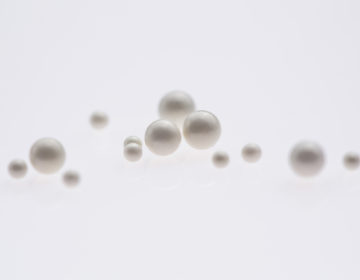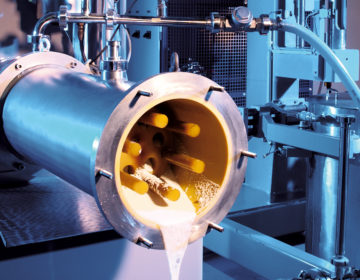Comminution processes play a central role in the preparation of particles for products such as paints, varnishes, inks, special chemicals and also ingredients for medicines. Finest particles are essential when it comes to colour properties, durability, but also functionality and effect. A distinction is made between grinding and crushing by converting larger starting particles, such as colour pigments, into smaller particles in the micrometer and nanometer range with the aid of mechanical energy. Here, on the one hand, there is the dry grinding process, which achieves particle sizes of up to around 10-100 µm. Another is the wet grinding process, in which the particles are comminuted as solids in suspensions or dispersions down to a few nanometers. In both processes, beads are used as an aid for the transmission of mechanical energy. They are the tools that transfer their energy to the particles to be comminuted by mechanical forces and movement. The comminution takes place in bead mills, especially in the wet grinding process in so-called agitator bead mills. Both have in common that a rotating agitator with discs or special agitator units drive the beads and thus the moving beads transfer their energy (impact, shear, shock) to the particles and cause them to collapse. Bead mills are also used for the production of suspensions, in which the beads serve as an aid to the destruction of agglomerates, i.e. particles held together by low forces.
Quality and know-how
Each production batch undergoes a complex quality control with regard to diameter, roundness, abrasion behaviour, surface, internal structure and specific weight.
With our wealth of experience and know-how in the field of grinding technology, we have established as specialists.
In addition to the production and sale of grinding beads, we are also very intensively involved in process engineering in wet grinding. In our production for ceramic beads and in our pilot plant we ourselves work with agitator bead mills and can therefore provide our customers with practical advice and optimise their production processes by means of suitable measures.
Service
In addition, we offer recycling and reworking of beads used in the mill.
Thus we enable our customers to save cost savings in bead consumption.
We stand for high quality of our products and for effective use of our grinding beads in order to achieve the highest customer benefit.
Bead Selection
Important rules for selecting the correct grinding media size
The correct grinding media size depends on the particle size of the product to be ground at the beginning of the grinding process and the desired particle size at the end of the grinding process.
Differentiations that should be made:
- Real shredding and disagglomeration
- Easy-to-shred products: Smaller grinding media can be used
- Products that are difficult to shred: Larger grinding media are more effective
The grinding beads should be 2 – 3 times larger than the separator or filter of the mill (e.g. slotted sieve, sieve cartridge, friction gap).
The grinding media should be at least 5 times smaller than the distance between agitator disc and grinding vessel wall.
The size of the grinding media should be approx. 20 to 30 times larger than the particle size (d95) of the grinding product at the beginning of the grinding process.
Achievable average particle size (d50) of the ground product after grinding is approx. 1/1000 of the size of the grinding media.
Example: Grinding media size 2 mm → d50 = 0.002 mm = 2 µm











